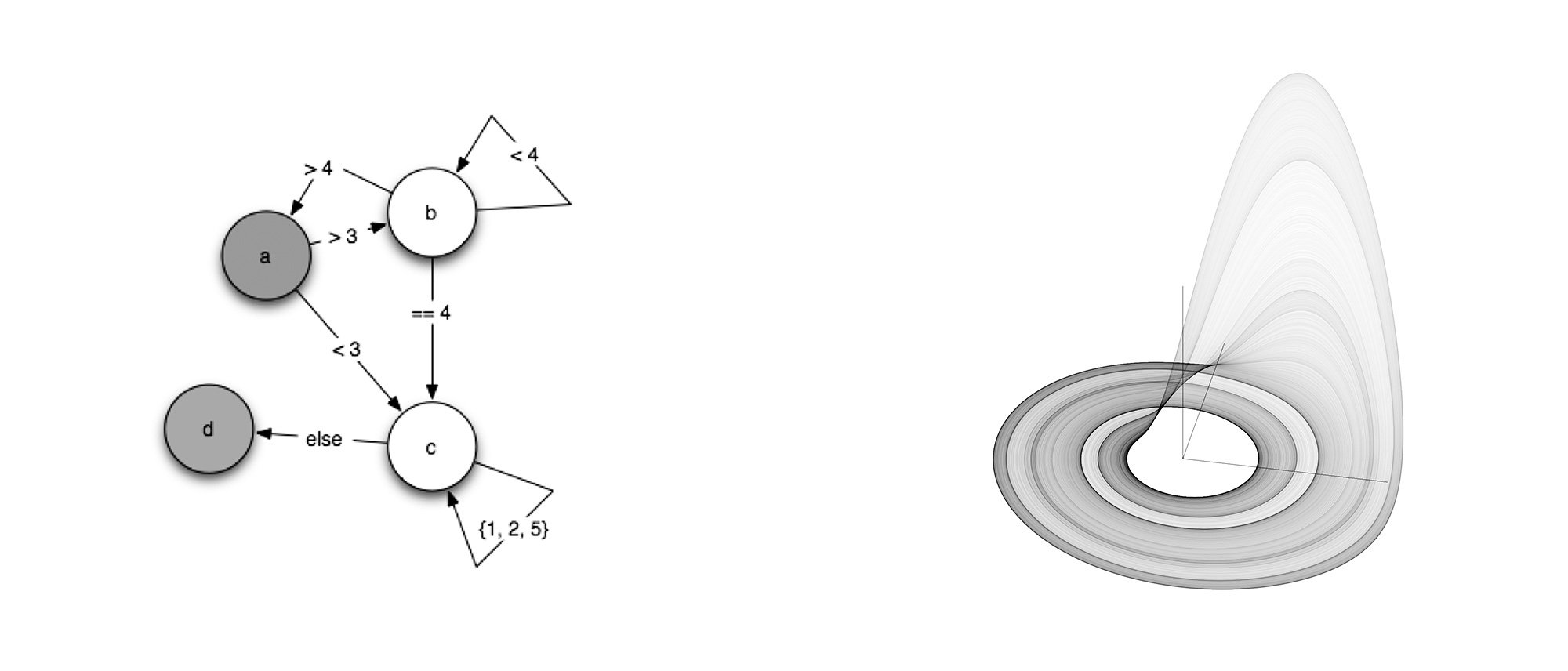Till Bovermann (2016)
A workshop series proposal for the MA program “performance ecology”
This workshop series introduces “artificial (sonic) ecologies” and invites participants to create, model and interfere with them on various levels.
Time frame
Two times two weeks intense workshop, i.e. 5 days a week, 4-5h per day.
Objectives
Even more in our contemporary age of environmental crisis, the investigation of issues surrounding ecology and performance requires a basic understanding of the complex interrelations that characterise even simple ecologies. This workshop series offers knowledge of modelling and simulation techniques as means to gain insights in the effects of ecologies as dynamic, spatio-temporal feedback systems. Alongside a series of hands-on experiments, validity and applicability of this method will be critically reflected.
Outcome
The outcome of the course will be a basic understanding of practice and limitations of ecology modelling (cybernetics of 1’st and 2’nd order, differential equations, state diagrams, Markov chains), and the ability to both construct and interfere with artificial (sonic) ecologies. On a side line, the course introduces rudimentary sound and interaction programming in the interactive programming environment SuperCollider.
Methods
Participants will gain insights on how to represent, implement and manipulate artificial (sonic) ecologies. They will
- get an introduction to sound programming in SuperCollider
- gain an overview on diagrammatic and textual representations of e.g. finite state machines, Turing machines and differential equations
- use live coding techniques to influence and alter their simulations in situ.
Program
Introduction to dynamic systems
A group improvisation in which participants invent and follow simple rules, creating complex higher-level behaviour.
An example for such an event-score:
Material:
+ 12m black yarn, knotted into a loop
+ 6 times two hands
Preparation:
1. 3 participants hold on to the yarn with both hands, spanning it into a ring
2. the rest of the participants grab the yarn with each hand between the left and right hand of different participants and pull them out so that they afterwards stand in the circle with the rest.
Dynamics:
+ If you feel a pull on the left hand, pull on the right hand.
+ If you feel a pull on the right hand, loosen the left hand.
+ Invent a "secret rule" that only you follow and know of.
Introduction to programming time-based structures
Create and play modular synthesis in open-source software with a few lines of code, play them with MIDI controllers and joysticks. No prior programming skills required.
// Using an implementation of the Rössler attractor
// x' = -y-z
// y' = x + ay
// z' = b + z(x - c)
// to create sound
Ndef(\lorenz, {
var roses, freqs;
freqs = [69 - 12, 69, 73, 84].collect{|v| v + rrand(-4, 4)}.midicps;
roses = RosslerL.ar(\rfreq.kr(1082),
a: \a.kr(0.2),
b: \b.kr(0.2),
c: \c.kr(2),
xi: {0.1.rand}!freqs.size);
Splay.ar(
roses.collect{|a, i|
SinOscFB.ar(freqs[i] * (1 + (a[0] * 0.01)), a[1].linlin(-2, 2, 0, 2)) * ([1, 0].choose -a[2])
})
}).play
A SuperCollider program creating complex sonic behaviour.
Constructing artificial ecologies
Introduction to finite state machines
FSM is a high-level visual language to describe (simple) discrete behaviour based on states and conditioned transitions between them. Participants will implement simple machines and let them run. Each state will be linked to a specific parameter set of a sound; emerging dynemic structure is made audible.
Differential equations, an alternative description language.
The Lotka-Volterra model/Predator-prey model is a set of first-order, non-linear, differential equations frequently used to describe the dynamics of biological systems in which two species interact; one as predator, the other as prey. We will use this to get a basic understanding of the modelling technique and then sonify it.
Another example for a complex system is the logistic map. It is often referred to as “an archetypal example of how complex, chaotic behaviour can arise from very simple non-linear dynamical equations.” [wikipedia]
 Finite state machine (left), Rössler attractor (right, by User:Wofl, CC BY-SA 2.5, source)
Finite state machine (left), Rössler attractor (right, by User:Wofl, CC BY-SA 2.5, source)
The Rössler attractor is an example of a chemical reaction system that features rhythmically interesting structures which makes it worth to investigate for musical qualities.
 Chip interpretation performance setup
Chip interpretation performance setup
With this knowledge, the course moves on to Turing machines and introduces Chip interpretations, a simple model of a computer chip where the computation itself can be made audible.
Re-synthesise!

This part of the workshop deals with the question how behaviour found in natural environments can be captured, turned into a model and eventually fed back into physical manifestation.
Participants will learn how to use basic machine listening techniques like amplitude, pitch and rhythm/event tracking. Markov chains will be used to (naïvely) imitate observed dynamic processes. The model’s output is fed back as sound into the environment.
Yoik-coin
Optionally, the course can look at crypto-currency trading as a playground for complex system behaviour. An introduction into the basics of Bitcoin and related currencies would be followed by outlining and eventually creating a custom crypto-currency based on natural phenomena.